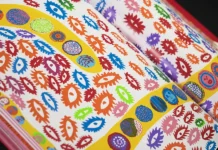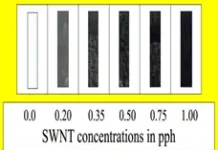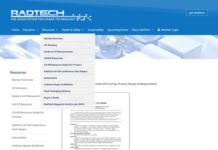By Theresa Thompson, Ph.D., Application Scientist, Phoseon Technology
Ultraviolet (UV) LED technology for curing is one of the market segments that has gained worldwide acceptance and continues to grow. But, there are many other industrial and life sciences applications throughout the UV spectrum that utilize UV LED technology. This article examines the effectiveness of UV LED for decontamination and disinfection applications.
UVC is known as “germicidal UV” for its effectiveness in decontamination and disinfection. While particular wavelengths affect different bonds within biological molecules, both nucleotides and proteins can be modified by deep ultraviolet light. Thus, both microorganisms and biological material can be inactivated with the right dose. (See Table 1.)
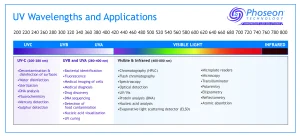
High-intensity UV LED technology offers unmatched levels of deep UV irradiance, which enables significant process improvements, including faster analysis and operations, and increased capabilities for decontamination and disinfection applications that require low wavelengths. UV LED technology enables complete inactivation of contaminants in minutes, as compared to traditional methods (Table 2).

This article makes the case as to why UV LED technology deserves serious consideration by research labs and manufacturing facilities for inactivating biological molecules and microorganisms. It describes research findings related to the different levels of inactivation.
Decontamination: Inactivation of Biomolecules
High-irradiance UV LEDs successfully inactivate biological molecules such as DNA and RNA. Hard targets, such as RNase A, can be completely inactivated with the right wavelength and intensity of UV. Complete inactivation of laboratory contaminants can be accomplished by UV LED in under five minutes and at a fraction of the cost of traditional methods.
Disinfection: Inactivation of Microorganisms
Ultraviolet light-emitting diode technology provides a new method for inactivating microorganisms. UVC, or germicidal UV, is effective for its disinfection properties, the perfect choice for sensitive surfaces of a laboratory or equipment. (See Table 3.) UV LED inactivation of microorganisms assures that surfaces are disinfected without chemicals and time-consuming rinsing.

Effectiveness of UV LED for Inactivating Ribonucleases (RNases)
In a lab environment, the single most important aspect of RNA protocols is isolating and maintaining full-length, un-degraded RNA for analysis or use as a reaction substrate. Hindering this process is the presence of RNase. Whether preparing total RNA libraries for Next Generation Sequencing (NGS) or looking at individual RNAs (iCLIP), degradation by RNases is a recurring laboratory handling issue requiring diverse cleaning methods.
RNases – specifically RNase A – are difficult to irreversibly inactivate in the absence of long-term heat treatment or harsh chemicals. Such methods may be incompatible with common laboratory materials or complicate subsequent biochemical reactions. Fast, complete and irreversible inactivation of RNase A with mercury arc lamp sources has been difficult to achieve due to low power output at targeted wavelengths and the need to filter harmful wavelengths that do not contribute to the inactivation.
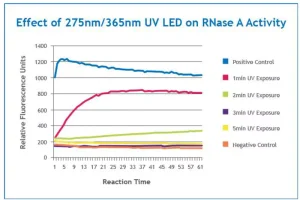
Reported here is the use of high-irradiance UV LED engines for enzyme inactivation. Results show that both irradiance (intensity) and radiant fluence (dose) contribute to rapid inactivation of the RNase A enzyme. UV at 275 nm is thought to act on RNase A via an effect on the aromatic amino acids proximal to disulfide bonds. The 365 nm wavelength is targeted to the lysine side chain with the intent to destabilize the RNase A reaction pocket. These two wavelengths interact synergistically to inactivate RNase A (Figure 1). We conclude that high-intensity UV LED irradiation represents a novel, fast and convenient irreversible inactivation method for RNases on surfaces.
Effectiveness of UV LED for Inactivating Clostridium Difficile
Clostridium difficile spore transmission from contaminated surfaces is a continuing problem for healthcare facilities. Clostridium difficile, also known as Clostridioides difficile and often referred to as C. difficile or C. diff, is a bacterium that can cause symptoms ranging from diarrhea to life-threatening inflammation of the colon. In a study from Phoseon, high-intensity UV LED was used to rapidly inactivate Clostridium difficile spores.
High-intensity UV LED 275 nm alone and 275 nm + 365 nm combination, wavelengths targeted to protein disulfide functional groups, drive a greater than 5 log (5.79 log) colony forming units (CFU) reduction of Clostridium difficile spores on a surface in less than 30 seconds. This is consistent with results showing synergism between 275 nm and 365 nm high-intensity UV LED when irreversibly inactivating RNase A. Targeting protein stabilization and functional groups represents a new approach to spore inactivation.
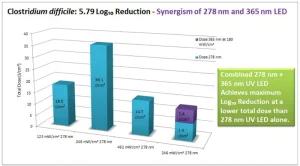
High-intensity UV LED technology effectively inactivated C. diff spores by 5.79 log10 in seconds. (See Figure 2.)
Effectiveness of UV LED for Inactivating Staphylococcus Aureus
Staphylococcus aureus contamination of food processing and contact surfaces is a source of foodborne infection for consumers of meat and meat products. In this study, surfaces contaminated with high loads of Staphylococcus aureus were exposed to 265 nm UVC LED to assess the effects of multiple doses and irradiances.
One-inch square stainless steel targets inoculated with S. aureus were exposed to a UVC LED (265 nm) array source at 1.3, 1.5, 2.0, 2.5 and 3.0 mW/cm2 (at the target) from a distance of 15 mm. Doses ranged from 26 mJ/cm2 through 150 mJ/cm2.
Surviving bacteria were plated and colony forming units assessed. Log reduction was calculated as the difference in the log of geometric means between the unexposed control and the exposed test samples. Each test sample included four independent exposures at each condition.
Irradiances of 1.3 and 1.5 mW/cm2 resulted in four- to five-log reduction of Staphylococcus aureus colony forming units on exposed targets. This corresponded to doses of between 20 and 52 mJ/cm2. Increasing the irradiance to 2, 2.5, and 3.0 mW/cm2 to deliver a dose of 150 mJ/cm2 resulted in a five-log reduction in all cases.
Short 265 nm UVC exposures of ≤60 seconds were sufficient to result in a four-log reduction of Staphylococcus aureus. Treatment of food products by 265 nm UVC LEDs represents a viable investigation path for decreasing foodborne Staphylococcus aureus infections in consumers.
Conclusion
UV has been recognized for decades for its ability to inactivate biological molecules. However, complete inactivation of difficult targets, such as enzymes and spore-forming microorganisms, has been out of reach for traditional UV sources. By targeting specific molecular bonds, UV LED technology exhibits higher efficacy with lower total power consumption than broadband sources such as mercury. UV LED technology is enabling new methods and discoveries by research labs.
A UV LED system has been developed that surpasses 5 W/cm² at 275 nm, significantly higher than the levels reached previously by other LED systems, and surpassing many other technologies in the market by an order of magnitude. This milestone development enables users to utilize UV LED systems where they were prohibited in the past, bringing improved disinfection capability to various processes. LEDs are on the verge of reaching sterilization levels for difficult and clinically relevant pathogens.
In addition to high-performance decontamination and disinfection systems, exciting research is on the way in other applications as well. Studies are underway to extend the breadth of data to reach higher levels of disinfection (with a goal to achieve sterility) and include more organisms – specifically viruses and mixed cultures.
Phoseon Technology has pioneered the use of LED technology for Life Science and Industrial Curing applications, delivering innovative, highly engineered, patented LED solutions. The company is focused 100% on LED technology and provides worldwide support. For more information about Phoseon Technology products and services, please contact Theresa Thompson at theresa.thompson@phoseon.com, visit www.phoseon.com or call 503.439.6446.
References
Rapid inactivation of RNase A by high irradiance UV LEDs; Thompson, T,; Eliason, G.; Pasquantonio, J. American Society of Cell Biology/European Molecular Biology Organization Scientific Sessions 2017 https://phoseon.com/wp-content/uploads/2019/06/ASCB-EMBO-poster_Tabloid_v2.pdf
Theresa L. Thompson and Jay Pasquantonio “High-intensity UV LED inactivation of Clostridium difficile spores.” Proc. SPIE 10863, Photonic Diagnosis and Treatment of Infections and Inflammatory Diseases II, 1086314 (7 March 2019); doi: 10.1117/12.2507993; https://doi.org/10.1117/12.2507993
Pasquantonio, J.; Eliason, G.;Thompson, T. “Reproducible Inactivation of Staphylococcus aureus on a Surface Using UV LED.” International Association for Food Protection 2019, Louisville, KY https://iafp.confex.com/iafp/2019/meetingapp.cgi/Paper/21498
Breakthrough UV-C LED Performance Enables New Life Science Applications. https://phoseon.com/wp-content/uploads/



